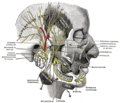This article may be too technical for most readers to understand.(June 2025) |
| Mental foramen | |
|---|---|
 Mandible. Outer surface. Side view. (Mental foramen visible at left.) | |
| Details | |
| Part of | Mandible |
| Identifiers | |
| Latin | foramen mentale |
| MeSH | D000080383 |
| TA98 | A02.1.15.007 |
| TA2 | 845 |
| FMA | 53171 |
| Anatomical terms of bone | |

The mental foramen is one of two foramina (openings) located on the anterior surface of the mandible. It is part of the mandibular canal. It transmits the terminal branches of the inferior alveolar nerve and the mental vessels.




